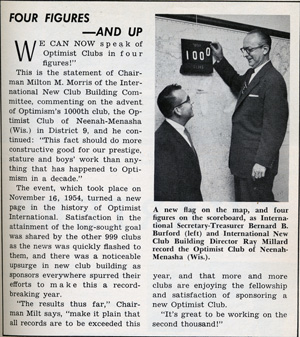Optimist International originated several other programs in the 1950s. One of these was the organization of an all-out campaign against the illegal sale and use of narcotics, especially among young people. At the 1954 International Convention, delegates passed a resolution asking all Optimists and Optimist Clubs to urge legislation for more severe penalties against the illegal sale of narcotics. At the 1955 convention, Optimists endorsed the death penalty for the conviction of an illegal narcotics sale to a juvenile. Legislation called for in the resolution was adopted by the U.S. Congress in 1956. Club resolutions, speakers’ bureaus, public meetings, newspaper and radio publicity were all designed with the purpose to alert parents to the seriousness of the situation and to solicit their help in stopping it. Parents were urged to be on the lookout for such pornographic materials in their own mailboxes and, if any was discovered, to forward it at once to their local Post Office. Another social problem plaguing post World War II society was school dropouts. Again, Optimist International organized a program of action to meet it. Many Optimists personally engaged in the Stay-in-School Program through service on committees that met with school officials and youth leaders and then with the young people themselves to encourage them to continue their education and to offer any assistance needed to remain in school. |
|
| One of the programs to emerge during this period that still enjoys participation by Clubs is the Respect for Law program, an effort to combat apathy toward crime and the dispensation of justice. It started with reports of shocking examples of what was perceived to be a growing attitude of “I don’t want to get involved.” One of those occurred on the streets of New York where a young woman was brutally attacked and murdered even though 40 persons reportedly heard her screams but didn’t try to help her or call the police. Incensed by this and other similar incidents, Optimist International partnered with the U.S. Federal Bureau of Investigation and the Canadian Royal Mounted Police in developing a program. |
